Friday Library Recommendations: Lost Species
My theme for #FridayLibraryRecommendations this week links to Remembrance Day for Lost Species, which is this Sunday, November 30th. It is a chance each year to explore the stories of extinct and critically endangered species, cultures, lifeways, and ecological communities.
My first choice this week is Around The World In 80 Endangered Animals by Jess French, illustrated by Brendan Kearney, a vibrant and informative non-fiction book for young readers who are curious about the natural world and the creatures we share it with.

Taking readers on a journey across deserts, oceans, rainforests and frozen landscapes, it introduces 80 endangered animals in an engaging and accessible way. From gentle whale sharks gliding through deep waters to polar bears navigating drifting ice, each page offers a glimpse into the lives of remarkable species facing real challenges.
I love the balance between fascinating facts and clear explanations about why these animals are at risk. The text highlights not only the threats they face but also the inspiring conservation work happening right now to protect them. This encourages children to understand both the fragility of nature and the positive actions that can make a difference.
The book is richly illustrated, making it easy for children to visualise each animal and its habitat. A standout feature is the large pull-out poster on biodiversity, which shows how every species, no matter how small or unusual, helps keep our planet healthy.
Perfect for readers who love animals, geography or science, this is a thoughtful and uplifting introduction to environmental awareness.
My next pick is Land Of The Lost Wildcat by Lui Sit, illustrated by David Dean, an exhilarating debut that combines heart-pounding adventure with a touching exploration of family, friendship, and the importance of preserving our natural world.
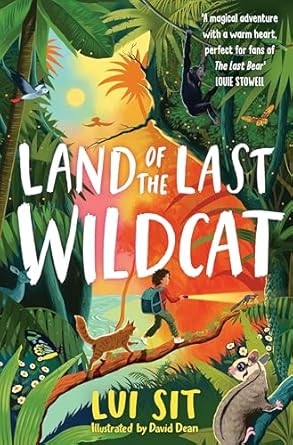
This exciting and imaginative adventure follows Puffin Lau, a determined young girl facing two big challenges: her scientist mother barely speaks to her, and a mythical wildcat — the kuri — needs her help to survive. Raised on stories about the kuri’s magical powers, Puffin is determined to return the creature to its rightful home. But standing in her way is the sinister Professor Smoult, a scientist driven by greed who wants to capture the kuri and exploit its magic.
From the moment Puffin encounters the kuri, the action unfolds at a thrilling pace, that kept me on the edge of my seat. The journey to Linger Island is filled with danger, suspense, and moments of magical wonder. The stakes are high, and the story does not shy away from addressing the real-world consequences of greed and exploitation. The kuri’s plight as an endangered species mirrors the real-world struggles faced by countless animals. Lui’s vivid descriptions of the natural world are both beautiful and poignant, encouraging us to think about our own relationship with nature and the importance of protecting it.
I do love a good villain and Lui has definitely given us one in Professor Smoult, whose greed and disregard for the natural world make him perfect for a story centred on conservation and respect for the environment.
The illustrations by David Dean bring key moments of the story to life and add depth to the characters and settings, and capturing the magical essence of the kuri. A must-read for young animal lovers and fans of magical realism that captures the imagination while delivering a powerful message about environmental responsibility.
And finally, I’ve chosen Turtle Moon by Hannah Gold, a warm, exciting and thought-provoking adventure, beautifully complemented by Levi Pinfold’s atmospheric illustrations.
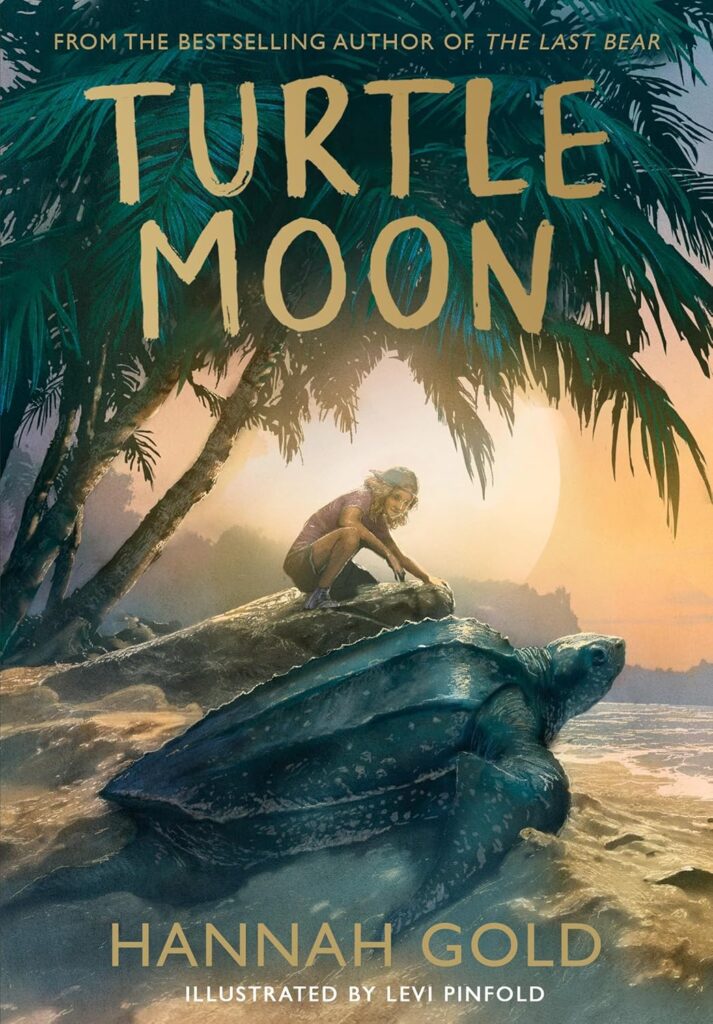
It follows Silver Trevelon, a young girl whose family has been stuck in a quiet sadness ever since the baby sibling they hoped for never arrived. When Silver’s dad is offered the chance to work at a turtle rescue centre in Costa Rica, the family swaps grey skies for tropical heat — and Silver discovers a world alive with colour, wildlife and possibility.
Hannah weaves real-world environmental themes into a gripping story that feels both accessible and meaningful for primary-aged readers. Children will be fascinated by the work of the rescue centre and especially by Silver’s unforgettable encounter with a nesting leatherback turtle. But when the turtle’s eggs mysteriously vanish, the pace quickens. Silver and her new friends must summon courage, resilience and teamwork as they journey deep into the jungle to uncover the truth.
This is a story about hope, healing and the power of young people to make a difference. It balances tension with tenderness, adventure with empathy. Ideal for confident readers aged 8 and up, Turtle Moon is an engaging eco-mystery that may spark brilliant conversations at home about nature, conservation and kindness.
Happy reading!
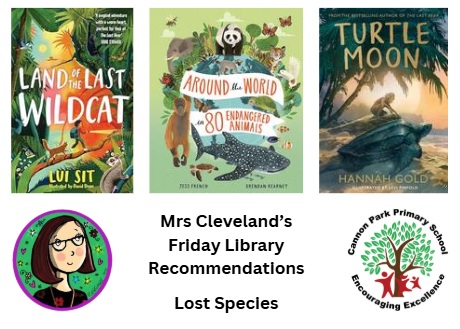
Wellbeing Wednesday: Winter Wellness
Tips for wellness from our Mental Health In Schools Team

“To appreciate the beauty of a snowflake it is necessary to stand out in the cold.” – Aristotle
Winter Wellness
It is important to focus on our wellness during the colder months. Winter is a time where our bodies may start to crave the same warmth and comfort we had during the summer months. We might associate winter with the winter blues, but we need to try and create some space for self-care and slow down to nourish our physical and mental health! Sometimes we might feel the winter blues because of the lack of sun and vitamin D we are getting. This is why our mental wellbeing should be a big focus during these months, and we should find creative ways to stay on track, keep up motivation, and look after ourselves.
Our Top Tips For Winter Wellness:
- Wrap up warm and lay down with a blanket and a hot drink.
- Do some fun activities outside in the natural sunlight such as going for walks or seeing friends (you might need to wrap up warm for this!) Even on cold days, fresh air and natural llight boosts our mood.
- Stay active – try indoor exercises to help get your body moving during the colder months. You could keep your energy up by dancing, swimming, or practising yoga. You could also find an exercise video online for you to do at home!
- You might even want to go to your local café and read a book in the daytime or have a warm relaxing bath when you’re home after a cold day.
- Keep up your routines- getting up in the morning is harder in winter when it’s cold and dark. Shorter days also make it tempting to sleep more, but consistent sleep helps your mind feel balanced.
- Eat well and stay hydrated — good nutrition fuels your brain and body.
- Talk about how you’re feeling — sharing your thoughts can help if you’re feeling low or stressed.
Remember to always make time for yourself at the end of a long day! For more ideas on how to maintain your mental health this winter, follow this link.
Please contact [email protected] for information and advice about mental health and well-being for your child and your family.
Wellbeing Wednesday: Motivation
Tips for wellness from our Mental Health In Schools Team

“Nothing will work unless you do.” – Maya Angelou
Motivation
Motivation is what helps you start and keep going with your goals, this may be linked to school, hobbies or life stuff. It is the ‘why’ behind what you are doing. Motivation can help you to finish a task or practise a new skill, it can make learning and playing more fun and help you to feel proud when you have done something great.
Sometimes it can be difficult to find motivation to begin an activity. To help with this, think about what is your ‘why’. Ask yourself what goal matters to you and connect with what excites or inspires you.
Our Top Tips For Motivation:
- Set small and clear goals: Break big tasks into bite-sized steps. Ensure you celebrate each smaller win along the way.
- Create a routine that works for you: Having a plan for your day can help to keep you on track and reduce potential stress.
- Remain positive: If you are finding an activity difficult, remember to be kind to yourself. If something is hard, say, ‘I am learning’ instead of ‘I can’t do it’.
- Ask for help: It is ok to ask family, friends or teachers for some help when you get stuck.
- Motivational matching activity: Write some goals down on individual pieces of paper e.g., ‘to finish my homework’ and some motivational reasons down on another piece of paper e.g., ‘to help me learn new things’. Spread the paper around upside down. Take turns flipping them over to match a goal with a motivational reason. When a pair is found, have a conversation about why that motivation may help to achieve the goal. Consider any barriers to achieving the goal and plan how you could overcome them.
Please contact [email protected] for information and advice about mental health and well-being for your child and your family.
Wellbeing Wednesday: Be Helpful
Tips for wellness from our Mental Health In Schools Team

“Our prime purpose in this life is to help others.” Dalai Lama
Be Helpful
Being helpful means doing something kind for someone else — like sharing, listening, or offering a hand — even in small ways. When you help, your brain feels safe and happy. It teaches empathy, kindness, and gratitude — all great for mental health!
Why being helpful is good for you:
- Boosts your mood: Helping others releases feel-good chemicals in your brain.
- Builds Confidence: You’ll feel proud and capable when you make a difference.
- Creates Connection: Helping brings people together and reduces loneliness.
- Reduces Stress: Focusing on others can calm your mind and improve wellbeing.
Our Top Tips For Being Helpful:
- Start Small – You don’t have to do something huge – even small acts of kindness matter! Holding a door, sharing a smile or helping with a chore all count.
- Listen First – Sometimes the best way to help is to listen and being there for someone who needs to talk.
- Spread Positivity – Compliments, encouragement, and gratitude go a long way. They make everyone feel good!
- Make it a habit – Try to do one helpful thing every day. The more you practice kindness, the more natural it feels!
- Work as a team – Helping doesn’t mean doing everything alone. Teamwork makes helping fun and easier for everyone.
- Reflection time – After helping someone, take a minute to think: How did it make you feel? How did it help the other person? What did you learn about kindness?
Examples of how to help others:
- Sit with someone who is alone at lunch time
- Give family or friends a kind note to brighten their day
- Help your neighbour to take their shopping in
- Offer to tidy the classroom or help your teacher hand out resources
Please contact [email protected] for information and advice about mental health and well-being for your child and your family.
Friday Library Recommendations: Lest We Forget
Next Tuesday is Armistice Day, so this week, I have chosen books that highlight the bravery and resilience shown throughout the Second World War.
My first choice is War Dog by Tom Palmer, Illustrated by Carolina Rabei; a moving and beautifully illustrated picture book that tells the extraordinary true story of Judy, a brave and loyal dog who lived through the Second World War.
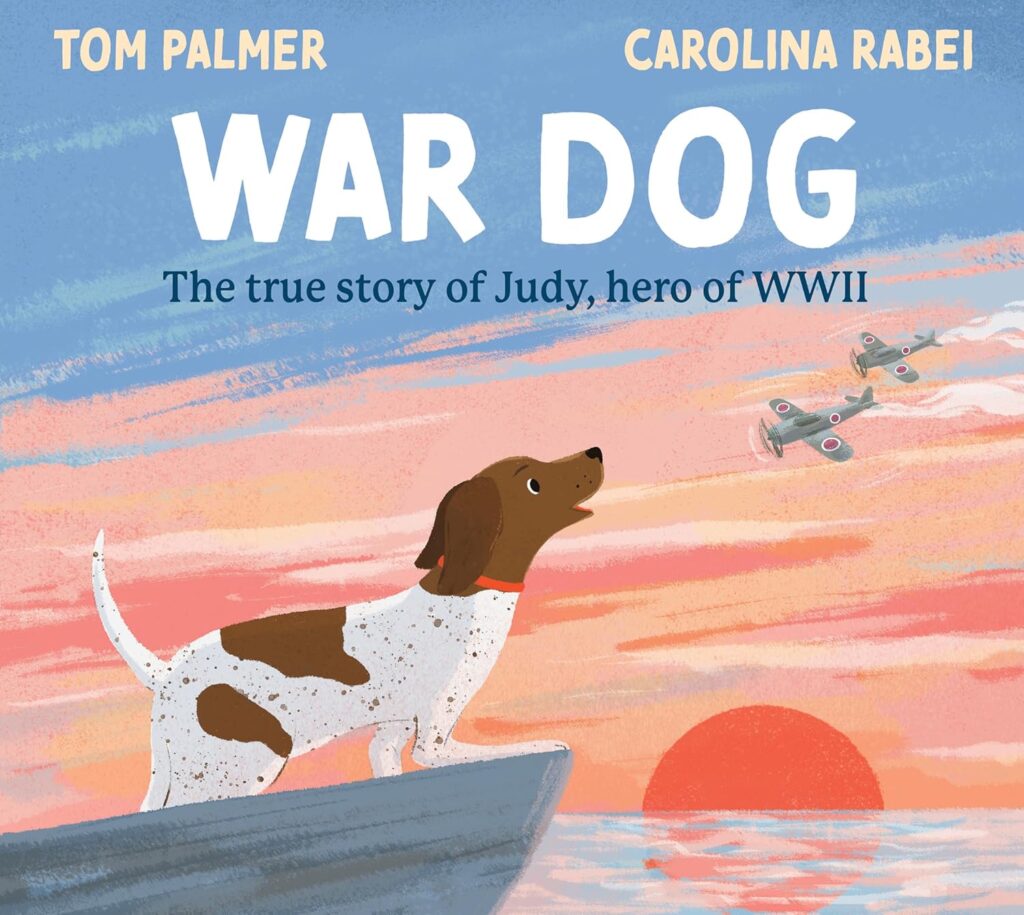
Judy is the mascot of a ship called HMS Grasshopper and quickly becomes an important member of the crew. She spends her days catching rats, looking out for anyone who might fall overboard, and listening carefully for signs of danger. Most of all, she offers comfort and companionship to the sailors during a frightening and uncertain time.
Judy’s bond with the crew, especially a kind man named Frank, shows the deep connection between people and animals. When disaster strikes and the soldiers are taken prisoner, Judy is separated from Frank. She must find the courage to survive and reunite with the people she loves. Her loyalty and bravery give the men hope and strength when they need it most.
This remarkable story is based on real events. Judy was the only dog to be made a prisoner of war and was awarded the Dickin Medal, which is an honour given to animals for their bravery during wartime. Tom Palmer tells her story with warmth and clarity, making it accessible for young readers while also sparking thoughtful conversations about history, kindness and courage.
Carolina Rabei’s illustrations bring Judy’s journey to life with emotion and vivid detail, making the book both educational and deeply touching. A special non-fiction section at the back of the book shares fascinating facts about animals in wartime, which adds an extra layer of learning.
War Dog is an inspiring and heartfelt read for families. It is perfect for children who love animals or history and is a wonderful way to introduce them to real stories of heroism.
My next choice, for our older chilrden is Shrapnel Boys by Jenny Pearson; a gripping and heartfelt story set during the Second World War. It follows Ronnie Smith, a young boy growing up in London in 1939. When war begins, Ronnie feels a mixture of fear and excitement. At night he lies awake listening to the bombs falling, but in the morning he races out with his friends to collect pieces of shrapnel from the streets. To them, it is a thrilling game, but the danger around them is very real.
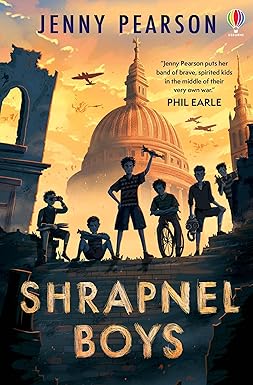
Ronnie’s world is not just shaped by the war outside. Trouble is also brewing at home. His brother is keeping secrets and getting involved with mysterious new friends and a risky job. Ronnie begins to worry that his brother may be in more danger than he realises. When Ronnie tries to help, he uncovers secrets far bigger than he expected, secrets that could affect more than just his family.
Jenny Pearson captures the bravery, fears and friendships of children living through wartime with warmth and honesty. She shows how ordinary children had to grow up quickly, facing challenges and responsibilities that would be unimaginable today. Ronnie is a relatable and courageous character, and readers will cheer him on as he tries to protect the people he loves.
This book offers children an exciting and fast-paced story while also giving them a glimpse into real history. It is perfect for sparking conversations about family, courage and what it was like to be a child during the war. Shrapnel Boys is both thrilling and moving, making it a fantastic choice for young readers who enjoy adventure and stories about friendship and resilience.
And finally, I’ve picked a non-fiction book that is perfect for sharing with a grown-up. Blitz Kids: True Stories From Children Of War Time Britain by Duncan Barrett and Nuala Calvi. a powerful and moving book that shares the real experiences of children who lived through the Blitz during the Second World War. It paints a vivid picture of what life was like for young people in cities across the UK as bombs fell from the skies and the world around them changed overnight.
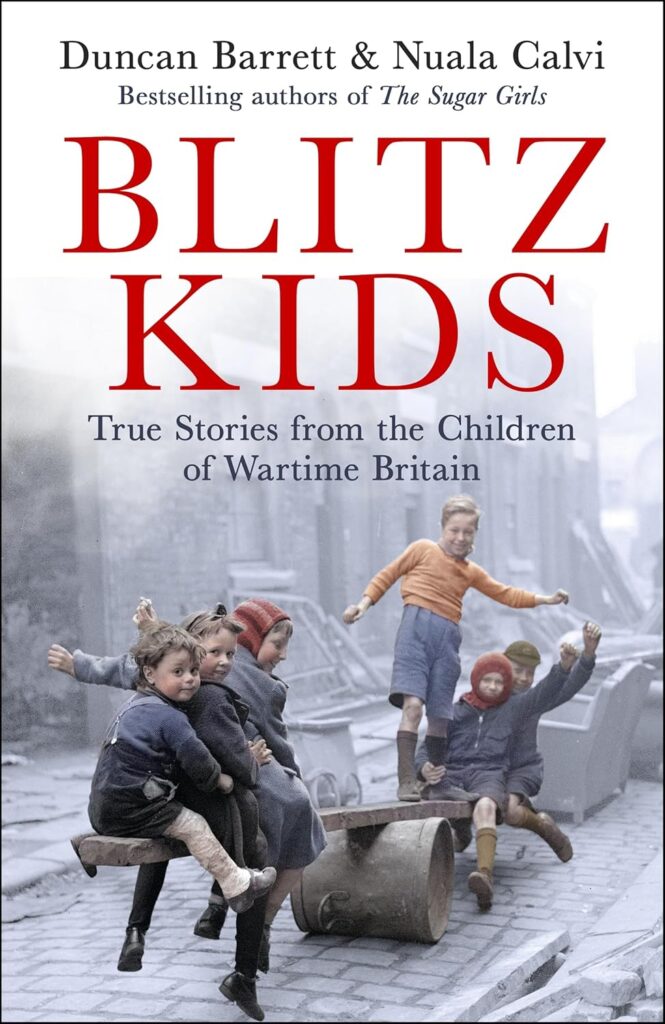
Through the voices of children like Kitty from London, Christopher from Liverpool and Doreen from Coventry, the book brings history to life in a way that feels real and immediate. These children spent nights in cold and crowded air raid shelters, listening to the terrifying sounds of planes and bombs. In the morning, some discovered their homes and schools had been destroyed. Many lost pets, possessions and even family members.
Yet these children also showed incredible resilience. They made their own fun, collecting shrapnel, exploring bombed-out houses and chasing American soldiers for chocolate and chewing gum. Their stories are a reminder of how strong and brave young people can be, even in the darkest times.
This book is best shared with an adult, as some of the stories can be emotional and may raise important questions about war, loss and courage. Reading together can help children talk through what they are learning and understand the historical context more clearly.
Blitz Kids is a wonderful resource for families who want to explore real history in a meaningful and personal way. It helps children connect to the past, understand how it felt to live through wartime Britain, and appreciate the resilience of a remarkable generation. It is both a moving tribute and a powerful conversation starter for young readers and their families.
Happy reading!
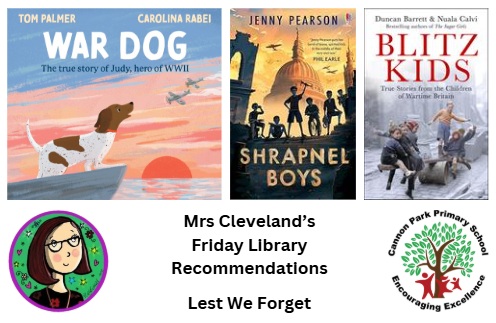
Wellbeing Wednesday: Digital Detox
Tips for wellness from our Mental Health In Schools Team

“Real life begins where Wi-Fi ends” – Anonymous
Digital Detox
Taking a digital detox is important to give our minds and bodies a break from screens and technology. Too much screen time can lead to tired eyes, difficulty sleeping, and feeling stressed or distracted. Stepping away from devices helps us to recharge, focus better, improve our mood, and spend more quality time with family and friends. It also encourages healthier habits like playing outside, reading, and being creative, all of which support overall wellbeing!
Our tips for taking a digital detox:
- Set yourself clear limits for screen time – Set specific time limits for screen time, such as an hour after school or 30 minutes of games or social media. Try setting limits on your device, or a visual reminder.
- Create Scree-Free Zones – When you are eating meals with your family or friends, leave your phone or devices in a different room. This allows you to talk and enjoy your food without distractions and improves your quality of connections with others.
- Avoid screens at night – Try to avoid using devices in your bedroom, most importantly for at least 30 minutes before bed. Keeping your bedroom a peaceful space can help you to fall asleep more easily.
- Do fun activities without screens – Try drawing, playing a game with your family, playing a musical instrument or reading instead of your usual device. Spend time outdoors if you can!
- Take small breaks from screens – After playing video games or watching TV for a while, get up and move around. Try to take short breaks where you move between rooms, stretch or walk around.
- Turn off notifications – This can reduce the number of distractions and help you focus on what is important to you. You might even discover a new activity you enjoy!
- Find mindful alternatives – Try meditating or doing breathing exercises to reduce feelings of stress, rather than screen use.
Please contact [email protected] for information and advice about mental health and well-being for your child and your family.
